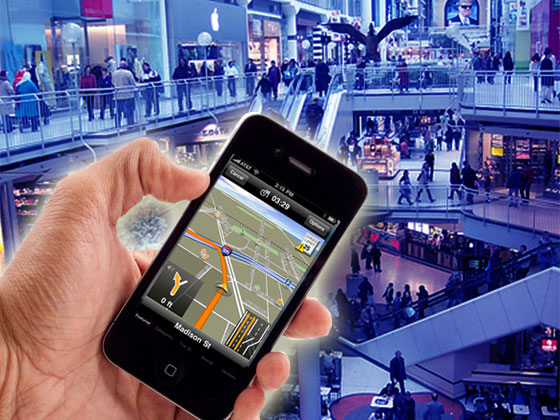I remember the first time I used GPS on a phone. It was nothing short of life changing. We laugh now about the time before everyone could simply type any address and follow the dot to your destination. Its hard to remember the days when you’d write down directions and tell someone to meet you at a certain spot, hoping for the best.
So we take it for granted that generally the functionality of our best GPS and smart phones stops at the door of any building or structure. IPS, an acronym for indoor positioning systems, has been evolving over time, but it’s still not ready for primetime on your smartphone. There are a number of complications. One is accuracy; non-government GPS is only accurate to 30-50 meters at any given time to where you may actually be located. That’s fine to get you across town, but its not good enough to serve you interactions relevant to the context of your immediate surroundings. Another is being indoors; GPS signals don’t penetrate solid structures very well. Specifically for retail, the problem posed is that if you’re standing in the Banana Republic store men’s section and it happens to be located next to the Victoria’s Secret store, without very specific geo-fencing boundaries you could start receiving coupons and content for women’s lingerie. 30-50 meters makes a big difference in cities and shopping malls.

The other challenge faced is that without continuous high levels of cell coverage specifically placed inside a structure, you can’t receive interactions at all and various floors in buildings prohibit this. Many stores now provide free wifi, but customers have to connect and reconnect each time they go into a new store. All of these reasons have made mass adoption of in-store mobile interactions a challenge. Shopkick was the first company to break through many of these barriers by producing a hardware box that retailers install which emits a high pitch sounds waves that are inaudible to customers but not to the microphones of your smartphone. Using points and gamification, they guide customers around the store and expose them to new products. Shopkick is the only company that has been offering this capability, but you need to already have Shopkick’s mobile app to take part.
That’s where beacons come in.
So-called beacons, the term made popular in press releases recently by Apple and PayPal are a new low cost, low energy way to signal when a customer walks through a zone. A beacon uses BLE (Bluetooth Low Energy) and basically creates an invisible zone. When a customer enters the zone, it signals the phone to receive certain content or offers in the case of retail. This means that as you walk around a store, your phone has more clear departmental and aisle-specific context and isn’t depending at all on GPS or Wifi. You do have to have wifi on and an app that will interact with the BLE zone to trigger an action. Basically, if you choose to, your phone can now become a highly relevant receptor of everything that’s around you and retailers can get all the more creative on how to interact with customers.
BLE transmitters - iBeacons!
This is a big step forward in making retail environments more in-sync with the smartphone wielding shopper, though there are still considerable limitations to beacon zones. Although a beacon can be highly customized for an area of say 10-50 feet, it is not able to get granular at the individual product level. You may be able to get designer content from Ralph Lauren when you walk into the Polo section, but if you want to interact with a specific sweater, a beacon zone won’t cut it. In order to engage at the individual product level you still need a product tag, whether its NFC, QR or image recognition. They all have their pros and cons, but tagging is still a necessity to fully engage.
CloudTags’ goal is to optimize the in-store experience like websites. Product level interactions are core to what we do. We see beacons as a cost effective innovation to broadly serve interactions to people while NFC can then bring a much greater level of specificity. CloudTags tablets now work off both beacon signals as well as NFC tags and the combination allows the shopper to have context as they walk around the store, while still allowing product-level engagements. Both are key to a location-based omnichannel platform experience.
Apple and Paypal have both offered their own unique solutions – iBeacon and PayPal Beacon respectively (even though the names aren’t unique). iBeacon will allow iPhones to receive interactions from these BLE signals. They have not yet offered a payment option but there is much speculation that with the number of iTunes accounts with saved payment details and their recent announcement of fingerprint protected access to phone, that it’s a likely possibility. For Paypal the BLE signal is used to trigger payments as the primary purpose. Once you set your permissions at the retailer level, as they check you out, you simply have to walk out and a picture of your face will be flashed on the screen as you walk out. The implications for payment are certainly exciting in their ability to change customer behaviors.
In order to fully simulate the beauty and simplicity of experience that the Web has brought online, enhancements are needed to make the iPhone able to touch and tap objects in the physical world. Beacons are a great step in using hyper-location, but more innovation will have to happen to merge the physical and digital worlds in full.